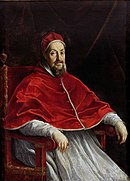| Papal conclave February 1621 | |
|---|---|
| Dates and location | |
| 8–9 February 1621 Apostolic Palace, Papal States | |
| Elected pope | |
| Alessandro Ludovisi Name taken: Gregory XV | |
 | |
In the papal conclave held from 8 to 9 February 1621, Cardinal Alessandro Ludovisi was elected to succeed Paul V as pope. Ludovisi took the name Gregory XV. It was the shortest conclave in the seventeenth century.[1]
Death of Paul V
[edit]Pope Paul V died on January 28, 1621, in the 16th year of his pontificate. At the time of his death, there were seventy cardinals in the Sacred College, but only sixty nine were valid electors. Fifty one of them participated in the election of the new Pope.
Factions in the Sacred College
[edit]There were three main parties in the Sacred College, with cardinal-nephews of the deceased Popes as leaders:[2]
- Borghesian party – the faction of Cardinal Borghese, nephew of Pope Paul V. It grouped twenty nine cardinals created by this Pontiff.
- Clementine party – It grouped thirteen cardinals of Clement VIII. Formally their leader was Camerlengo Pietro Aldobrandini, nephew of Clement VIII.
- Sixtine party – small party of Vice-Chancellor Alessandro Montalto, cardinal-nephew of Sixtus V. It grouped six cardinals.
Three cardinals of the Italian ruling families (d'Este, Medici and Sforza) were not counted among the members of these factions.
It was generally thought that the next Pope would be the candidate chosen by Cardinal Borghese, because he was the most influential person in the Sacred College. He wanted to elect his friend Cardinal Campori, and already before opening the conclave he had obtained twenty four declarations in his favor. Although Campori had two significant opponents (Republic of Venice and Cardinal Orsini), Borghese was sure that he would be able to achieve his election on the first day of voting, by acclamation.[2]
The election of Pope Gregory XV
[edit]The conclave began in the evening of February 8. On the next day, Cardinal Borghese tried to elect Campori by acclamation, but failed because many of his friends defected and aligned themselves with Orsini, who had secured French support for his action against Campori. Facing such strong opposition, Campori withdrew his candidature.[2]
In the subsequent scrutiny (the only one during this conclave), the greatest number of votes received (fifteen) were for Jesuit Cardinal Robert Bellarmine,[2] but he had already declared in the previous conclave that he would not accept papal dignity in the case of his election. Now, at the age of 78, Bellarmine did not change his mind.[3]
The rest of the day the most influential cardinals: Borghese, Orsini, Zapata, Capponi, d'Este and Medici, spent on looking for a compromise candidature.[2] Finally, the leaders of factions agreed to elect aged and ill Cardinal Alessandro Ludovisi of Bologna, who seemed to have been the ideal candidate for a temporary pontificate.
On that same day, at about 11 o’clock in the evening, all the cardinals assembled in the Capella Paolina and by acclamation elected Alessandro Ludovisi to the papacy.[4] He accepted his election and took the name of Gregory XV.
Legacy
[edit]Pope Gregory XV in his Bull Aeterni Patris Filius (November 15, 1621) prescribed that in the future only three modes of papal election were to be allowed: scrutiny, compromise, and quasi-inspiration. His Bull "Decet Romanum Pontificem" (March 12, 1622) contains a ceremonial that regulates these three modes of election in every detail. The ordinary mode of election was to be election by scrutiny, which required that the vote be secret, that each cardinal give his vote to only one candidate and that no one vote for himself. Most of the papal elections during the sixteenth century were influenced by political conditions and by party considerations in the College of Cardinals. By introducing secrecy of vote, Pope Gregory XV intended to abolish these abuses. The rules and ceremonies prescribed by Gregory XV were kept substantially the same until Pope John Paul II issued the constitution "Universi Dominici Gregis" in 1996.[5]
Notes
[edit]- ^ Vatican History: Konklavechronologie Archived 2014-04-13 at the Wayback Machine
- ^ a b c d e Vatican History Archived 2007-09-27 at the Wayback Machine
- ^ Vatican History: Konklave 1605 (Paul V) Archived 2007-09-27 at the Wayback Machine
- ^ Konrad Eubel, HIERARCHIA CATHOLICA MEDII ET RECENTIORIS AEVI vol. IV, p. 15
- ^ The Catholic Encyclopedia (public domain)
References
[edit]- Baumgartner, Frederic J. (2003). Behind Locked Doors. Palgrave Macmillan. ISBN 0-312-29463-8.